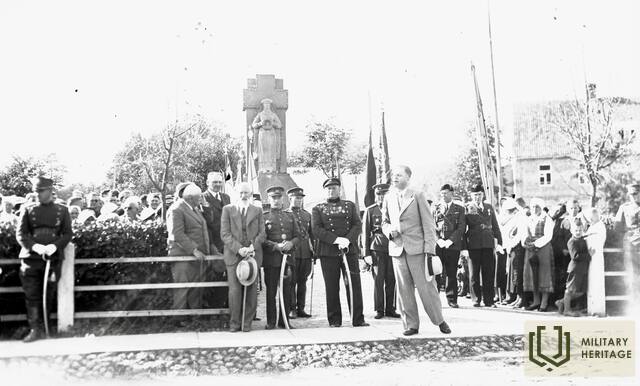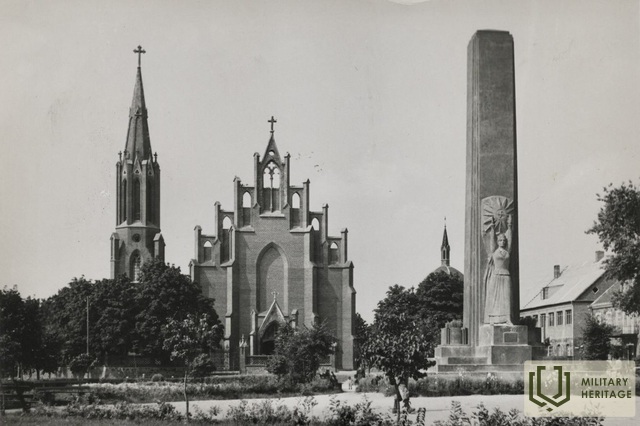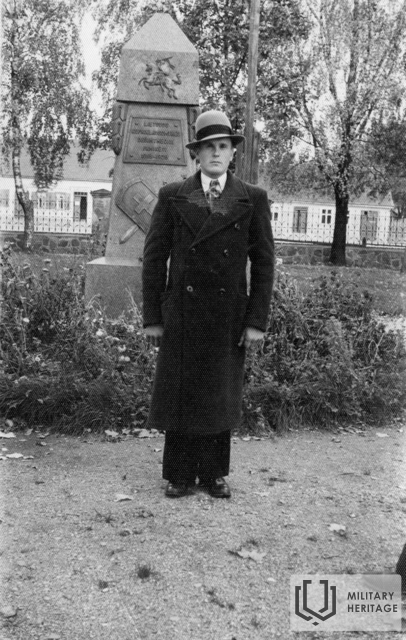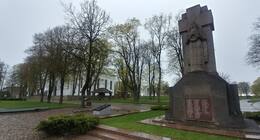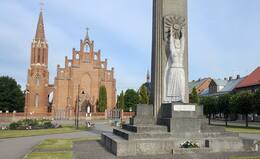Monuments to Lithuanian Independence. Histories of monuments created by Roberts Antinis: (I) interwar period
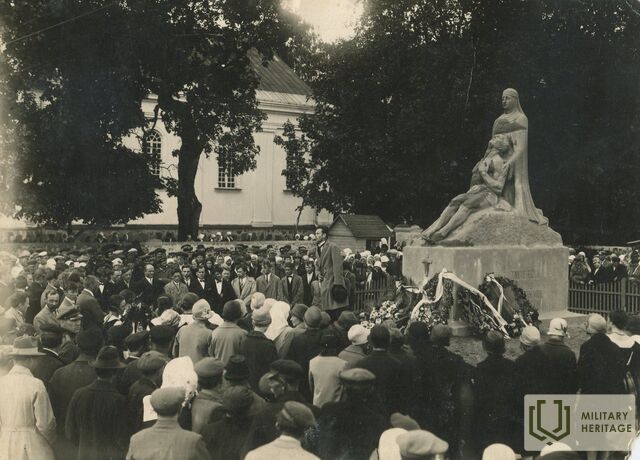
Around 1928, a boom in the construction of monuments to commemorate the 10th anniversary of Independence and the battles for Independence began in Lithuania, testifying to the patriotic mood of Lithuanians and their civic spirit. In this case, it is worth highlighting the works of sculptor Roberts Antinis, created in 1926–1931.
In 1919, after successfully repelling the attacks of the Bolsheviks and Bermontists, concern was raised about the perpetuation of these battles and their heroes. On December 15, 1919, the Commander-in-Chief of the Lithuanian Armed Forces issued an order to establish the Lithuanian War Museum (Order to the Lithuanian Army No. 205). However, Lithuania faced another challenge - battles with Polish military units. It was possible to take more solid steps only after all the battles had ended, after November 1920. Again, without delay, he returned to the issues of establishing a war museum. On January 22, 1921, In 1991, an order of the Ministry of National Defence was signed, obliging the organisation of such a museum and at the same time defining the purpose of this institution – “to create for future generations an eternal monument to how Lithuania, tormented by enemies for centuries, threw off the shackles of slavery and, with arms in its hands, achieved independence through pain and struggle” (Order to the Army No. 17). Less than a month passed and on February 16, commemorating the Day of the Restoration of the State of Lithuania, the museum was solemnly opened. Today it continues to successfully exist as the Vytautas the Great War Museum.
Soon, concern was also expressed about the arrangement of the graves of those who died in the Independence Struggles, and around 1928, a boom in the construction of monuments to commemorate the 10th anniversary of Independence and the Independence Struggles began. In this case, it is worth highlighting the works of sculptor Roberts Antinis (the elder).
Robertas Antinis was born in 1898 in Latvia (then the Russian Empire), in Kaldabrunia. He studied in Rokiškis, later studied art in Kaunas and Paris. In 1927–1931, several Lithuanian cities were decorated with Independence monuments created by him. The first one was erected in Širvintos. In November 1920, battles between the Lithuanian and Polish armies took place in the vicinity of Giedraičiai and Širvintos, known as the Battle of Giedraičiai. Then the Lithuanian army managed to repel the Polish forces advancing into the depths of the country. It was to commemorate these events that the monument created by Antinis was erected in Širvintos in 1927. It is said that Antinis himself participated in the Independence battles, fought near Širvintos. Other monuments created by him were erected in Biržai, Rokiškis and possibly Kretinga (all unveiled in 1931). While there is doubt about Antinis' authorship in the case of the Kretinga monument, the local stonemason Jonas Akinskas is considered to be the creator of the latter.
The monuments created by Antinis are characterized by sculptural accents. The monument in Širvintos depicts a kneeling mother holding her dying soldier-son; in Biržai, a Lithuanian woman holding a wreath in her hands pressed to her chest; in Rokiškis, on one side of the monument, there is a character and a Lithuanian soldier, on the other, a Lithuanian woman holding a sun with a swastika depicted on a shield in her raised hands. The monument in Kretinga was more modest, decorated with bas-reliefs with images of state and military symbols.
Monuments in Biržai, Rokiškis and Širvintos were built next to churches, in public spaces that had already been formed (city squares) or that soon became such due to the monuments that appeared there. The squares in Biržai and Rokiškis began to be called Independence Squares after the Independence monuments that were erected there. In the case of Kretinga, the monument was built in the square of the former town hall, and therefore also in the heart of the city. In 1875–1876, an Orthodox church, a witness to the oppression of the Russian Empire, was built in the middle of this square. In 1925–1927, this church was demolished and a new accent was erected in its place – the Independence Monument. So not only the monuments themselves were eloquent, but also the places where they were built.
The stories of the emergence of these monuments are also worthy of a separate story. It is again telling that these symbols of the national narrative appeared precisely thanks to the initiative of local people. The monument in Širvintos was erected with funds collected by the Committee for the Arrangement of Graves of Volunteers Who Died in the Fight for Independence. This committee was formed in 1925 on the initiative of the head of the Širvintos Bar of the Border Police, Juodenikis (Juodenukis, Juodemskas). In Biržai and Kretinga, the monuments were erected with the care of the local branches of the Lithuanian Riflemen's Union. All this testified to the firmly rooted patriotism and citizenship. The monument in Biržai was nicknamed "Birute" by the townspeople - in honor of the Grand Duchess of Lithuania and the mother of the historical hero Vytautas the Great, important to Lithuanians. The name "Mother" stuck to the monument in Širvintos, although others, as in the case of Biržai, saw Duchess Birute in the image.
During the Soviet era, most of the Independence monuments created in the interwar period were destroyed. This fate befell almost all of Antinis's monuments ( reference to the second part ). Only the sculptor himself was more fortunate. He was allowed to continue creating. The most famous work of Antinis from that period is the sculpture "Eglė žančių karalienė", erected in Palanga in 1960. In the 1960s, he also prepared projects for memorial complexes in Salaspils in Latvia and Kaunas IX Fort (unrealized).
- Gintaras Bielskis (ed.), "Those who died in battles will live forever", in: Širvintos region, 2015-07-28, available online: https://www.sirvinta.net/krastotyra/kovose-zuve-amzinai-gyvens/ .
- "Biržai - a monument to those who died for the Independence of Lithuania", in: Panevėžys County Gabrielė Petkevičaitė-Bitė Public Library, 2020-03-18, available online: https://paneveziokrastas.pavb.lt/virtuali-fotoparoda/lietuvos-valstybingumo-zenklai-panevezio-apskrityje-paminklai-laisvei-ir-nepriklausomybes-kovu-kariams-savanoriams-2/birzai-paminklas-zuvusiems-uz-lietuvos-nepriklausomybe/ .
- Aleksandras Indriulaitis, "Robertas Antinis", in: Universal Lithuanian Encyclopedia, 2024, available online: https://www.vle.lt/straipsnis/robertas-antinis/ .
- Aušra Jurevičiūtė, “Vytautas the Great War Museum – Creator of Lithuanian Military Traditions and Preserver of Military Heritage”, in: War Archive, 2019, no. 34, pp. 151–216, 294–295.
- Jolanta Klietkutė, “Monument to the Decade of Lithuanian Independence (1928–1928) in Kretinga (Freedom Monument)”, in: Kretingos krašto enciklopedija, 2014 (updated 2020-01-11), available online: https://www.kretingosenciklopedija.lt/kultura/kulturos-paveldas/istorinis-paveldas/paminklai/paminklas-lietuvos-nepriklausomybes-desimtmeciui-1928-1928-pamineti-kretingoje-laisves-paminklas/ .
- "Rokiškis - Monument to the Decade of Lithuanian Independence", in: Panevėžys County Gabrielė Petkevičaitė-Bitė Public Library, 2020-04-16, available online: https://paneveziokrastas.pavb.lt/virtuali-fotoparoda/lietuvos-valstybingumo-zenklai-panevezio-apskrityje-paminklai-laisvei-ir-nepriklausomybes-kovu-kariams-savanoriams-2/rokiskis-lietuvos-nepriklausomybes-desimtmecio-paminklas/ .
Related timeline
Related objects
Independence Square in Biržai
In the center of Biržai city.
A place of remembrance of the battles for freedom and a witness to the memory wars.
In 1931, on the former square next to the Church of St. John the Baptist, a monument to those who died for the Independence of Lithuania was erected at the initiative of the local team of the Lithuanian Riflemen's Union. The square became known as Independence Square, and the people of Biržai called the monument itself "Birute" (in honor of the Grand Duchess of Lithuania). The square became a place for various celebrations and commemorations. Flowers were laid at the monument, and riflemen or scouts' oaths were taken. After the Soviets occupied Lithuania, the monument did not last long - in 1946 it was blown up and buried where it stood. A cemetery for Soviet soldiers was established on the site of the Independence Monument.
In 1988, the people of Biržai excavated the remains of the destroyed monument. And in 1990, an exact copy of this monument was restored, only it was no longer erected in its original place, but further away, next to the cemetery of Soviet soldiers. In 2006–2007, the monument was restored, and a plaque with the names of 60 Lithuanian volunteers, soldiers, partisans and riflemen who died was attached to its pedestal. In 2017, another memorial plaque was unveiled next to the monument - to the knights and volunteers of the Vytis Cross of the Biržai parish in the 1919–1920 Independence battles.
In 2011, original fragments of the original monument were brought and exhibited next to the church.
In 2005–2010, the square was reconstructed. It is believed that in the 16th–17th centuries, this place was supposed to be an empty field between the castle's defensive moat and the townspeople's plots. Later, the area was divided into plots. When reconstructing the square, it was intended to reflect these stories: narrow, diagonal marks resembling cannonball trajectories semantically connect the square with the castle, and the wider lanes crossing the square more or less correspond to the boundaries of the townspeople's plots that were here in later times.
In 2021, the square was officially renamed Independence Square. The square remains the burial place of Soviet soldiers from World War II, marked by an obelisk and memorial plaques. It is believed that soldiers and spies from the NKVD-MVD-MGB units who died in battles with partisans in the Biržai region in 1945–1954 were also buried here.
Independence Square in Rokiškis
In the center of Rokiškis city.
The highlight of Independence Square is the monument erected in 1929–1931 to commemorate the 10th anniversary of Independence. The monument depicts a Lithuanian soldier and a Lithuanian woman holding a sun with a swastika depicted on a shield in her raised hands. This is one of those rare cases when a monument erected in Independent Lithuania during the Soviet era was not destroyed. Only in 1970 was the inscription “1918–1928” and the swastika plastered over. In 1989, the monument was restored.
Since the monument was erected in 1931, the square has been known as Independence Square.
A memorial plaque with the inscription “In this square, in the post-war years (1944–1953), the bodies of the fighters killed for the freedom of Lithuania were desecrated” commemorates one of the most painful stages in the history of this square. At least three buildings surrounding the square housed Soviet repressive structures that imprisoned, interrogated and tortured Lithuanian people in 1944–1953 (Nepriklausimobės a. 5, 10, 15). These buildings are marked with commemorative plaques.




